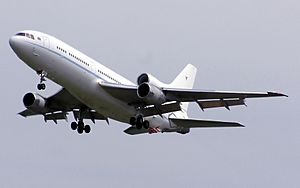No. 216 Squadron RAF facts for kids
Quick facts for kids No. 216 Squadron RAF |
|
|---|---|

Squadron badge
|
|
| Active | 5 October 1917 – 1 April 1918 (RNAS) 1 April 1918 – 27 June 1975 (RAF) 1 July 1979 – 20 March 2014 1 April 2020 – present |
| Country | |
| Branch | |
| Type | Drone swarm technology |
| Role | Test & Evaluation |
| Home station | RAF Waddington |
| Motto(s) | CCXVI dona ferens (Latin for '216 bearing gifts') |
| Battle honours |
|
| Insignia | |
| Squadron badge | An eagle, wings elevated, holding a bomb in its claws. Approved by King Edward VIII in May 1936. |
| Squadron codes | VT (Apr 1939 – Sep 1939) SH (Sep 1939 – Sep 1941) |
Number 216 Squadron is a special part of the Royal Air Force (RAF). It is currently based at RAF Waddington in Lincolnshire, UK. Since April 2020, its main job has been to test new drone swarm technology. Before this, the squadron flew large transport planes called Lockheed TriStars from RAF Brize Norton in Oxfordshire for many years.
Contents
History of No. 216 Squadron
Early Days: First World War
No. 216 Squadron started way back in August 1917. It began as a small group from No. 7 Squadron of the Royal Naval Air Service (RNAS). They used Handley Page O/100 planes for anti-submarine missions.
Later, this group moved to France and became a night bomber squadron. They flew missions to attack targets at night. On April 1, 1918, this RNAS squadron officially became No. 216 Squadron of the new Royal Air Force.
Between the World Wars
After the First World War, No. 216 Squadron changed its role. It became a transport squadron, moving people and supplies. They used planes like the Vickers Vimy and Vickers Victoria in the Middle East. In May 1936, the squadron got its official badge approved by King Edward VIII. This badge shows an eagle holding a bomb.
Second World War Operations
During the Second World War, No. 216 Squadron mostly worked as a transport unit. They flew different types of aircraft, including the Douglas Dakota. These planes helped move troops and supplies. The squadron spent a long time based in Cairo, Egypt, from 1942 to 1945.
After the Wars: Jet Age and Changes
After the Second World War, the squadron continued its transport duties. In the late 1940s, they started using Vickers Valetta planes. Then, in 1955, they moved to RAF Lyneham and began flying the De Havilland Comet C.2, which was a jet airliner. This was a big step into the jet age!
No. 216 Squadron was officially closed down in June 1975 after 58 years of service. However, it didn't stay closed for long.
The squadron reformed in July 1979. This time, it was a maritime strike squadron, meaning it would attack targets at sea. They flew Blackburn Buccaneer S.2 aircraft. These planes were even equipped with nuclear bombs for defense. But after a Buccaneer crashed during an exercise, the squadron's planes were combined with another squadron's. Even so, No. 216 Squadron was not officially disbanded again.
The Lockheed TriStar Era (1984–2014)
After the Falklands War, the RAF needed better ways to transport things over long distances. So, in 1982, they bought several large Lockheed TriStar planes.
No. 216 Squadron was reactivated in November 1984 to fly these TriStars. At first, they were used for transport. But soon, they also became important for Air-to-Air Refuelling. This means they could refuel other planes while flying, helping them stay in the air longer.
The TriStar fleet from No. 216 Squadron supported many important missions around the world. This included operations in the Gulf War, Kosovo, Afghanistan, Iraq, and Libya.
The squadron was disbanded again in March 2014, and the TriStars stopped flying. However, its story wasn't over.
Future Focus: Drone Swarm Technology (2020–present)
In July 2019, the RAF announced exciting news: No. 216 Squadron would reform once more! This time, its mission would be completely new and very modern.
Since April 2020, the squadron has been an experimental unit. Its job is to test and develop future drone swarm technology. This means they are working with groups of drones that can fly and work together. This is a very important and cutting-edge role for the RAF's future.
Aircraft Flown by No. 216 Squadron
Over its long history, No. 216 Squadron has flown many different types of aircraft. Here are some of them:
- Handley Page Type O/100 (1917–1918)
- Handley Page Type O/400 (1918–1921)
- Airco DH.10 Amiens (1920–1922)
- Vickers Vimy (1922–1926)
- Vickers Victora Mk.II (1925–1926)
- Vickers Victoria Mk.III (1926–1935)
- Vickers Victoria Mk.V (1929–1934)
- Vickers Victoria Mk.IV (1929–1931)
- Vickers Victoria Mk.VI (1933–1935)
- Vickers Valentia (1935–1941)
- Bristol Bombay Mk.I (1939–1943)
- de Havilland DH86B (1941–1942)
- Lockheed Hudson Mk.VI (1942–1943)
- Douglas Dakota (1943–1949)
- Vickers Valetta C.1 (1949–1955)
- de Havilland Comet C.2 (1956–1967)
- de Havilland Comet C.4 (1962–1975)
- Blackburn Buccaneer S.2B (1979–1980)
- Hawker Hunter T.7 (1979–1980)
- Lockheed TriStar C.1 (1984–1988)
- Lockheed TriStar C.2 (1985–2014)
- Lockheed TriStar C.2A (1985–2013)
- Lockheed TriStar K.1 (1986–2014)
- Lockheed TriStar KC.1 (1989–2014)
See also
- List of Royal Air Force aircraft squadrons




